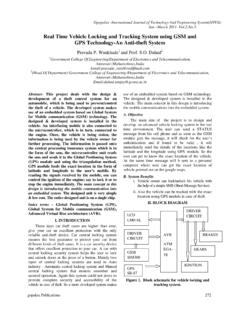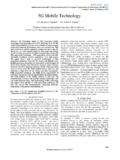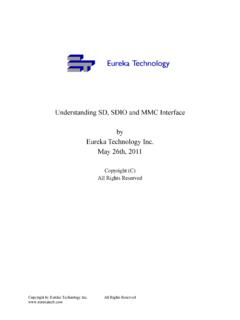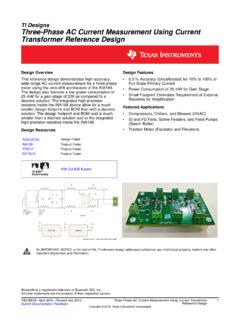Transcription of 5G Cellular User Equipment: From Theory to …
1 15G Cellular user Equipment: From Theory to practical hardware DesignYiming Huo,Student Member, IEEE, Xiaodai Dong,Senior Member, IEEE, and Wei Xu,Senior Member, IEEE,Abstract Research and development on the next generationwireless systems, namely 5G, has experienced explosive growth inrecent years. In the physical layer (PHY), the massive multiple-input-multiple-output (MIMO) technique and the use of highGHz frequency bands are two promising trends for (mmWave) bands such as 28 GHz, 38 GHz, 64 GHz, and 71 GHz, which were previously considered not suitablefor commercial Cellular networks, will play an important role in5G.
2 Currently, most 5G research deals with the algorithms andimplementations of modulation and coding schemes, new spa-tial signal processing technologies, new spectrum opportunities,channel modeling, 5G proof of concept (PoC) systems, and othersystem-level enabling technologies. In this paper, we first inves-tigate the contemporary wireless user equipment (UE) hardwaredesign, and unveil the critical 5G UE hardware design constraintson circuits and systems. On top of the said investigation anddesign trade-off analysis, a new, highly reconfigurable systemarchitecture for 5G Cellular user equipment , namely distributedphased arrays based MIMO (DPA-MIMO) is proposed.
3 Finally,the link budget calculation and data throughput numerical resultsare presented for the evaluation of the proposed Terms 5G, massive multiple-input-multiple-output(MIMO), millimeter-wave (mmWave), user equipment (UE), INTRODUCTIONIn the Cellular world, tremendous efforts have been devotedto delivering higher quality of service (QoS) and quality ofexperience (QoE) since the very first cell phone call was madein 1973. In the 3rd Generation Partnership Project (3 GPP)roadmap, several representative techniques have marked themilestones to further accelerate such trend, namely: device-to-device (D2D) communication for boosting geographic spec-trum reusability [1]; heterogeneous and small-cell network(HetSNet) targeting at deploying small cells in addition tomacro cells at the same or different carrier frequencies [2];carrier aggregation (CA) for larger radio frequency (RF)bandwidths.
4 New carrier type (NCT) for increasing spectralefficiency and spectrum flexibility, and reducing interferenceand power consumption [3]; higher order modulation schemesand more layers of spatial multiplexing (SM) for higherspectral efficiency (SE). In 3 GPP release 12,8 8multiple-input-multiple-output (MIMO) for downlink,4 4 MIMOfor uplink, 5 carrier components (CCs) and 256 quadratureamplitude modulation (QAM) are supported to satisfy theincreasing wireless capacity Huo, and X. Dong are with the Department of Electrical and Com-puter Engineering, University of Victoria, Victoria, BC V8P 5C2, Xu is with the National Mobile Communications Research Laboratory(NCRL), Southeast University, Nanjing 210096, China part of the QoS requirement of 5G networks, the 5G peakdownlink throughput (PDLT) is expected to achieve 10 Gbps inthe dense urban environments [4].
5 Delivering such high speeddata to end-users is an essential prerequisite for a satisfyingQoE which is perceived subjectively. Furthermore, this highPDLT can be translated into a very high SE requirementof at least 100 bits/s/Hz based on the maximum 100 MHzbandwidth (BW) that a mobile network operator currently cansupport through enabling 5 CCs. If the RF bandwidth is fixed,such high SE requirement leads to using either higher ordermodulation scheme, more layers of SM, or both. The PDLTis given byPDLT (BRF NQAM NCA NMIMO)(1)whereBRFis the RF bandwidth for one single carrier,NQAM represents the modulation order,NCAis the number of aggre-gated carriers, andNMIMO stands for the number of MIMO spatial multiplexing layer.
6 Therefore, the SE can be expressedasSE (NQAM NCA NMIMO).(2)Nevertheless, from the implementation point of view, highmodulation order and wide RF bandwidth unavoidably re-quire power-hungry, complicated and high-performance RFand baseband circuits. On the other hand, high order ofMIMO is confronted with the limitation of antennas physicaldimension, spacing, and radiation efficiency (RE). Based onemerging UE design techniques, a mobile phone handsetcan accommodate at most4 4 MIMO antennas with 256-QAM modulation [5], which theoretically boosts PDLT upto approximately 1960 Mbps when using 5 CCs.
7 On theother hand, such UE design already reaches the maximumspatial multiplexing gain due to the limited hardware area forembedding MIMO antennas of low GHz frequency bands. Asa result, at the UE end, the highest achievable SE is around 20bits/s/Hz. With the said SE, achieving 10 Gbps PDLT wouldrequire at least 500 MHz bandwidth, which is currently notpossible in terms of the limited spectrum holdings of , Wi-Fi technologies have been advancingrapidly. The cutting-edge off-the-shelf IEEE com-patible wireless products can support a4 4multi-userMIMO (MU-MIMO) for downlink.
8 By using unlicensed 60 GHz Millimeter-wave (mmWave) frequency bands, wirelessgigabit alliance (WiGig) IEEE products deliver evenhigher data rate for short-range communications [5]. The yetto be released IEEE and standards that [ ] 19 Jul 20172deemed as the successors of and respec-tively, are expected to provide improved QoS such as bettercommunication coverage and reduced latency. Besides WiFi,Bluetooth, near-field communication (NFC) and global navi-gation satellite system (GNSS) are also integrated in mobilehandset terminals. These wireless technologies will competewith Cellular for hardware resources and design budget onan already highly compact, multi-functional, multi-standardwireless handset terminal.
9 For example, a huge challenge is tointegrate antenna systems for different wireless technologiesthat occupy a very wide range of frequency (from 700 MHzto almost 6 GHz), and implementing high order MIMO canmake it even more serious considering the limited dimensionof a mobile handset light of these challenging issues in sub-6 GHz, the highGHz frequency bands used to be considered unsuitable forcommercial Cellular networks are now attracting significantattention. On July 14, 2016, the Federal CommunicationsCommission (FCC) voted to adopt a new Upper MicrowaveFlexible Use service in the licensed bands, namely 28 GHz( GHz), 37 GHz ( GHz), 39 GHz ( ), plus a new unlicensed band at 64-71 GHz [7].
10 Thisinitiative taken by the FCC helps mitigate the 5G UE designchallenges. First, larger continuous RF bandwidth enableshigher data rates. Second, using mmWave frequencies leads toa significant reduction of antenna dimension, and as a result,the form factor of the UE can be maintained while facilitatingbeamforming (BF) and spatial this paper, we present a novel distributed phased arrayMIMO (DPA-MIMO) architecture for 5G UE hardware remainder of this paper is organized as follows, Section IIinvestigates the contemporary wireless UE design and explainsthe design constraints.

![arXiv:0706.3639v1 [cs.AI] 25 Jun 2007](/cache/preview/4/1/3/9/3/1/4/b/thumb-4139314b93ef86b7b4c2d05ebcc88e46.jpg)

![arXiv:1301.3781v3 [cs.CL] 7 Sep 2013](/cache/preview/4/d/5/0/4/3/4/0/thumb-4d504340120163c0bdf3f4678d8d217f.jpg)
![@google.com arXiv:1609.03499v2 [cs.SD] 19 Sep 2016](/cache/preview/c/3/4/9/4/6/9/b/thumb-c349469b499107d21e221f2ac908f8b2.jpg)











